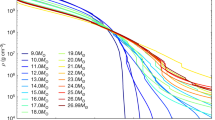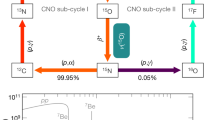Abstract
THE Brookhaven solar neutrino detector has been in continuous operation in its present form since 1970. The basis of the detection method is the inverse beta decay reaction on 37Cl to produce 37Ar (t½ = 35.1 d) which can be detected at a sensitivity level of 10 to 20 atoms. The detector, consisting of 380,000 1 of C2Cl4, is described in detail elsewhere (refs 1–3 and references therein). Measurements with this detection system establish1–3 an upper limit for solar neutrinos of 1 SNU (1 SNU = 10−36 captures/37Cl atom-s). This limit is in substantial disagreement with accepted solar model calculations4 which predict a result of 5.6 SNU (ref. 5). The significance of this discrepancy has been recently analysed in detail6; this number also represents a base line for comparison with other possible sources of high energy neutrinos3,7, in particular those produced by collapsing stars.
This is a preview of subscription content, access via your institution
Access options
Subscribe to this journal
Receive 51 print issues and online access
$199.00 per year
only $3.90 per issue
Buy this article
- Purchase on SpringerLink
- Instant access to full article PDF
Prices may be subject to local taxes which are calculated during checkout
Similar content being viewed by others
References
Davis, R. jun., Harmer, D. S., and Hoffman, K. C., Phys. Rev. Lett., 20, 1205–1209 (1968).
Proc. Solar Neutrino Conf., Univ. California, Irvine (edit by Reines, F., and Trimble, V.), see Rev. Mod. Phys., 45, 1 (1973).
Davis, R. jun., and Evans, J. C., Proc. 13th Int. Cosmic Ray Conference, 3, 2001 (Denver, Colorado, 1973); Revised 18/8/73 as BNL Report 17945.
Bahcall, J. N., and Sears, R. L., A. Rev. Astr. Astrophys., 10, 25 (1972).
Bahcall, J. N., Heubner, W. F., Magee, N. H., jun., Merts, A. L., and Ulrich, R. K., Astrophys. J., 184, 1 (1973).
Ulrich, R. K., Astrophys. J., 188, 369 (1974).
Bahcall, J. N., and Davis, R., jun., Phys. Rev. Lett., 26, 662 (1971).
Lande, K., Bozoki, G., Frati, W., Lee, C. K., Fenyves, E., and Saavedra, O., Nature, 251, 485–486 (1974).
Wolfendale, A. W., Young, E. C. M., Davis, R., jun., Nature phys. Sci., 238, 130 (1972).
Pallister, W. S., and Wolfendale, A. W., Nature, 251, 488–489 (1974).
Strong, I. B., Klebesadel, R. W., and Olson, R. A., Astrophys. J., 188, L1 (1974).
Bahcall, J. N., Phys. Rev., 135, B137 (1964); Phys. Rev Lett., 17, 398 (1966).
Bahcall, J. N., Astrophys. J., 145, 688 (1966).
Wilson, J. R., Astrophys. J., 163, 209 (1971).
Zel'dovich, Ya. B., and Guseinov, Kh., Soviet Phys. JETP Lett., 1, 109 (1965).
Colgate, S. A., and White, R. H., Astrophys. J., 143, 626 (1966).
Bahcall, J. N., Phys. Rev., 136 B, 1164 (1964).
Sehgal, L. M., Phys. Lett., 48 B, 60 (1974).
't Hooft, G., Phys. Lett., 37 B, 195 (1971).
Author information
Authors and Affiliations
Rights and permissions
About this article
Cite this article
EVANS, J., DAVIS, R. & BAHCALL, J. Brookhaven solar neutrino detector and collapsing stars. Nature 251, 486–488 (1974). https://doi.org/10.1038/251486a0
Received:
Revised:
Issue date:
DOI: https://doi.org/10.1038/251486a0
This article is cited by
-
Galactic neutrino sources and experimental neutrino astronomy
La Rivista Del Nuovo Cimento Series 2 (1976)
-
Chemistry of the solar neutrino problem
Nature (1975)
-
Relativistische Astrophysik
Die Naturwissenschaften (1975)
-
Possible explanations of the ‘high’ number of counts in the solar neutrino experiment
Nature (1974)



